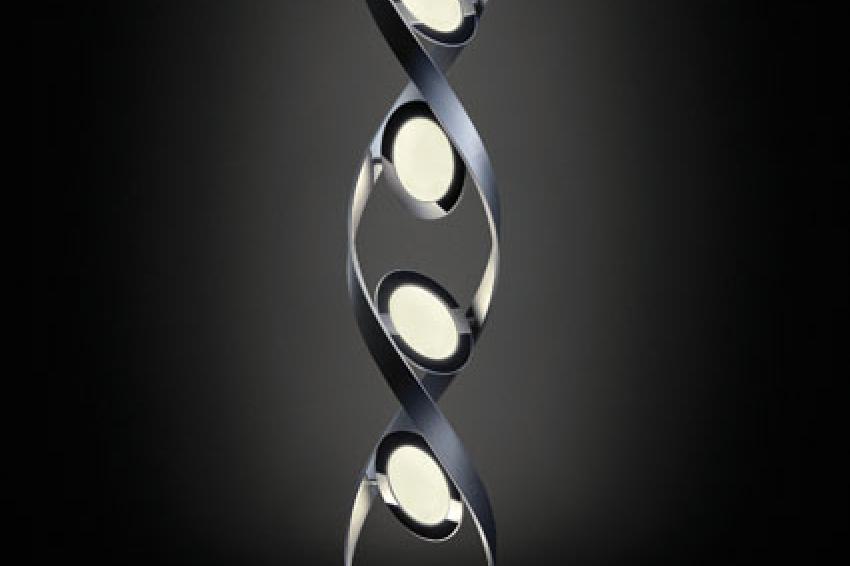Trends in Organic and Printed Electronics 2011
30.05.2011 -
OLEDs - Organic light emitting diodes - are capturing the creative fantasies of progressive light designers. Lightweight panels or "light tiles" composed of extremely thin functional layers on plastic or glass substrates make exclusive, futuristic looking OLED luminaires for home or office use. They are offered as commercial products by large vendors like Osram and Philips. OLEDs give off a pleasant warm-white light; they can be tuned to individual color temperatures and dimmed. And they are "instant-on:" at their full brightness right after flicking the switch.
A New Type of Light Source
With these basic properties, today's OLED lighting offers an outlook on an absolutely new type of light source: OLEDs are no spotlights; they need no reflectors or lenses to bundle and direct light beams onto the objects to be illuminated. Instead, they are large-area luminous surfaces flooding a room with diffuse, non-glare light. OLED panels are extremely thin - they will be easily embedded in walls, ceilings, windows, room dividers, car cockpits - turning them into luminous objects of their own.
Consequently, large-area OLEDs panels made from organic functional materials are triggering a second revolution in lighting technology: After the - ecologically mandated - end of incandescent light bulbs, which radiated more heat than light, and the subsequent transition to gas discharge and energy saving fluorescent lamps, the time has come for LEDs and OLEDs to shine. They port the principles and achievements of solid-state technology and its famed learning curve of exponential innovation and cost degression to a new generation of energy-efficient and eye-friendly lighting systems.
For display purposes, OLEDs are already widely present: in millions of mobile phones they serve as bright and color intensive screens, and TV sets equipped with OLED displays or OLED backlights for LCD-screens are on their way to the markets. Next in line is OLED lighting.
Luminous Efficacy and Lifetime on the Rise
OLEDs are superbly qualified as efficient sources of light. Today, in commercially available products, they realize a luminous efficacy of 23 lumens per watt, at a development goal of 100lm/W. Lifetime is up to 5,000 hours; three years from now it will be three times as much. Large, transparent OLED modules having an active light area of 1m2 are expected to evolve within a year though the German Federal Ministry of Education and Research public/private partnership project TOPAS 2012.
OLED light sources are manufactured without the use of mercury. Thus they fulfill the European RoHS regulation of eliminating toxic ingredients. OLED lighting needs no encasing or cooling devices. Currently they are measuring less than 2mm thick when fully encapsulated. Next step is thin flexible films, which can be formed and bent into any shape to form luminous objects of their own.
Technology Roadmap For OLEDs
The official roadmap of OE-A (Organic and Printed Electronics Association) sees the current uses of OLED lighting primarily in the high-end segments of exclusively designed luminaries as a market entry strategy. Over the next five years according to OE-A, OLED light tiles and large-area architectural lighting panels will further develop to enter the building material and industrial markets. From 2018 onwards OE-A expects low-priced standard OLED light fixtures to be available in various configurations and specifications as a universal illumination technology.
"The first solid-state lighting products are reaching the market," said Andy Hannah, CEO of Plextronics, a U.S. vendor leading the industry in providing key materials technology, such as functional inks used as efficiency increasing hole injection layers, for the mass printing of OLEDs. "That is clearly an indication of imminent widespread commercialization. Serving this enormous market will require large-scale production, which is only attainable through solution processing. Our new materials will enable our customers to manufacture high-quality lighting devices at the lowest cost."
Osram, through its LED subsidiary Osram Opto Semiconductors will be the first large European lamp manufacturer to invest more than €50 million in an OLED pilot manufacturing line in Regensburg, Germany, and further development of commercial OLED lighting. Already in 2008, Osram showed their first designer-style OLED luminaires. "For mass market applications," said Karsten Heuser, General Manager OLED at Osram, "light designers, besides a fascinating technology, need reliability and stable specifications. Our OLED lighting product families offer exactly that." In February, Osram introduced two new OLED lighting panels, one round, the other square, mirrored or transparent, respectively, in the off-state. With these panels, OLED designers will gain further creative dimensions to realize the light of the future.
LOPE-C 2011
At LOPE-C 2011 in Frankfurt June 28-30, OLED lighting will have a prominent place, with a special conference session dedicated to discussing the latest developments and market trends. The LOPE-C covers the latest commercial and technological achievements as well as the major economic trends and technological topics in organic, inorganic and printed electronics. It represents the entire industrial value chain - academic research to R&D, to production, to commercialization, to end-user cultivation. During the LOPE-C 2011 exhibition, OLED lighting will be shown and demonstrated as commercial products as well as the other major topics lighting, organic photovoltaics, displays, electronics & components as well as integrated smart systems. More than 95 companies are exhibiting; first timers are Agfa, Konarka, printechnologics or KIMM, just to name a few.
Conference Speakers Reflect Industry Trends
The LOPE-C conference, with over 150 presentations by industry leaders and technologists, will offer insight into the latest achievements in organic and printed electronics. The conference opens on June 28 with detail-packed, hands-on short courses and a Business Conference. Leading companies, such as Sumitomo Chemical, New Venture Partners, Airbus or Plastic Logic will discuss market-entry strategies and commercial opportunities in organic and printed electronics.
For more information on LOPE-C and to register please visit:
www.lope-c.com






